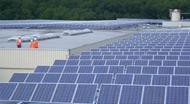Fighting climate change
Lafarge develops and is implementing a comprehensive climate change strategy. The Group surpassed its 2010 objectives 1 year in advance and set itself 3 new targets for 2015 and 2020.
Reducing CO2 emissions |
|
|
Lafarge is aware of challenge which climate change presents for the entire planet. Since 2001, the Group committed itself to ambitious objectives in the framework of a pioneering partnership with WWF. Lafarge has fulfilled and surpassed in advance its 2010 objectives. Specifically:
(* Gross/net emissions: net emissions equal gross emissions minus emissions related to the burning of waste.)
Going beyond plants The construction sector accounts for 40% of the global energy demand, and for 30% of the overall greenhouse gas emissions. In 2011, the Group announced it 2nd generation commitments, set up in the framework of the partnership with WWF International. Lafarge's 3 new targets for 2015 and 2020 are in line with a comprehensive, ambitious and original approach. They go beyond plants CO2 emissions and encapsulate the entire construction chain:
Relying on industrial ecology and innovation To meet these objectives, the Group is:
Lafarge also invests in research to:
|

CDP rankingIn 2010, Lafarge is n°6 worldwide in the Carbon Disclosure Project (CDP) TOP 50, a non financial rating agency. The CDP is the reference questionnaire on reducing CO2 emissions and managing climate change challenges. Lafarge is the 1st French company in this ranking where the Group has been present for the last 3 years. CO2 and cementWhy does manufacturing cement produce CO2? Cement manufacturing is the source of 5% of global carbon dioxide (CO2) emissions. The cement industry is a natural producer of CO2:
Climate SaversWithin the framework of their partnership, Lafarge and WWF have launched the environmental campaign "Climate Savers - Let the clean economy begin" to encourage leading companies to reduce their CO2 emissions. Industrial ecologyIndustrial ecology improves the way environmental factors (energy resources, natural raw materials, etc.) are integrated into business strategies. Industrial ecology takes its inspiration from the cyclical way in which natural ecosystems operate. Just as nature goes through cycles of production, destruction and recycling, industrial waste from certain activities can serve as raw material or fuel for other industries.
|
A debate that spans the construction sector |
|
Carbon assessmentAt the end of 2010, the independent French organization, ADEME (the Environment and Energy Management Agency), published a methodological guide comparing the carbon assessment of various construction systems for equivalent low-energy buildings (LEBs). The study revealed that, contrary to common perception, wood and concrete have the same comparable CO2 rating per m² for an individual LEB! |
The construction sector as a whole consumes a large amount of energy. The building is the source of 40% of the CO2 emissions of developed countries. As a responsible player, Lafarge seeks to reduce the environmental impact of construction and promote sustainable construction methods. The Group addresses all actors in the value chain and participates in partnerships and collective actions, such as:
|
Industrial ecology at the heart of operations |
|

BiomassBiomass refers to any organic material derived from plants that can be used to provide energy. It is the biodegradable portion of:
Kyoto ProtocolThe Kyoto Protocol aims to reduce greenhouse gas emissions on a global scale. The principle is based on varying levels of commitments for different governments. Industrialized countries have made stabilization or reduction commitments which correspond on average to a 5% reduction in their emissions for the period 2008/2012 compared with 1990. Developing countries are under no obligation but are encouraged to develop CO2 emissions reduction programs which can be used to generate credits: that is the principle of the "Clean Development Mechanism" (CDM) which involves promoting efforts in emerging countries. |
The Group's industrial ecology approach is built around finding ways to add value to waste. The underlying principle is that waste products from certain industries can serve as energy or raw material resources for other industries. In 2009, alternative fuels such as waste and biomass represented almost 11% of the fuel used by the Group. Promoting alternative energy sources For 30 years, Lafarge has been developing solutions to reduce energy consumption and diversify supplies. Examples of alternative fuel sources:
Using waste materials as an alternative to fossil energies has benefits for the Group and for local communities:
This approach also has positive effects in terms of CO2 emissions. Biomass is neutral in terms of CO2 while placing waste material in landfill produces greenhouse gases. Developing alternative materials Clinker, a key ingredient in cement manufacture, can also be partially substituted by waste. By adding industrial residues such as recycled construction materials and products derived from other industries, it is possible to:
|





